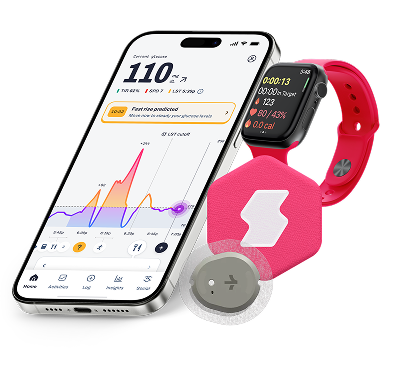Dark chocolate, often celebrated for its rich flavor and potential health benefits, presents a unique twist in the realm of glycemic indexes. While commonly associated with sugary confections, dark chocolate surprisingly boasts a low glycemic index due to its composition of healthy fats, antioxidants, and minimal sugar content.
Dark chocolate contains essential nutrients such as iron, copper, and magnesium, making it a potential dietary addition for individuals aiming to manage their blood sugar levels.¹ Furthermore, recent research from the European Journal of Clinical Nutrition suggests that consuming moderate amounts of dark chocolate might improve insulin sensitivity and reduce the risk of cardiovascular complications in individuals with diabetes.
This article aims to provide a comprehensive understanding of the nuanced impact of dark chocolate on glycemic control, offering insights into its potential benefits beyond mere blood sugar management.
Sign up to be the first to know about special offers and exciting Signos news.
Glycemic Index Table
Dark chocolate, a delectable treat often enjoyed for its complex flavors, has a low glycemic index of approximately 23.² With a serving size of 100g, it contains around 45g of carbohydrates.¹ Considering the glycemic load (GL) of dark chocolate, which accounts for both the quantity of carbohydrates in the food and its glycemic index, the GL per serving is approximately 10.
The glycemic index indicates how quickly a particular food can raise blood sugar levels, with values under 55 considered low. Dark chocolate's low glycemic index can be attributed to its composition, which includes healthy fats, minimal sugars, and notable levels of fiber. While cooking or processing may influence the glycemic index of some foods, dark chocolate generally maintains its low glycemic index across various forms, making it a potentially suitable option for individuals seeking to manage their blood sugar levels.
This comprehensive understanding of dark chocolate's glycemic index and the calculation of key nutritional values sheds light on the potential benefits of incorporating this delectable treat into the diets of individuals aiming to maintain stable blood sugar levels.

Nutritional Facts
With its rich and intense flavor, dark chocolate is not just a delightful treat but also a source of various essential nutrients. It is known to be rich in antioxidants, particularly flavonoids, contributing to its potential health benefits. Additionally, dark chocolate contains significant amounts of minerals such as iron, magnesium, and copper, making it a potentially valuable addition to a balanced diet.
A standard serving of 100 grams of dark chocolate contains approximately 11 grams of fiber, 67% of the recommended daily intake of iron, 58% of magnesium, and 89% of copper, highlighting its nutritional density and potential health-promoting properties.¹
The nutritional information below is for 100 g of dark chocolate.¹
Nutritional Facts

Is Dark Chocolate Good for Weight Loss?
While dark chocolate can be a part of a balanced diet, its direct impact on weight loss might be nuanced. However, some studies suggest that the consumption of dark chocolate, when included as part of a calorie-controlled diet, could potentially aid weight loss efforts. According to research published in the Journal of the American Heart Association, the polyphenols and flavonoids found in dark chocolate might contribute to improved metabolism and reduced inflammation, which could indirectly support weight management.
Nevertheless, the calorie-dense nature of dark chocolate necessitates cautious consumption within the context of an overall calorie-controlled diet to avoid potential weight gain, as emphasized by the National Institutes of Health. Therefore, while dark chocolate might have certain benefits related to weight management, it should be consumed in moderation as part of a well-rounded, calorie-controlled eating plan.
Is Dark Chocolate Safe for People Living with Diabetes?
Despite its slightly sweet and indulgent appeal, dark chocolate can be considered a viable treat for individuals with diabetes when consumed in moderation. According to recent studies published in the European Journal of Clinical Nutrition, the flavonoids present in dark chocolate could potentially aid in improving insulin sensitivity and reducing the risk of cardiovascular complications in individuals with diabetes.
Additionally, the low glycemic index of dark chocolate, as confirmed by the American Diabetes Association, means it has a minimal impact on blood sugar levels, making it a relatively safer option for those managing their glucose levels. However, it is important for individuals with diabetes to be cautious about dark chocolate's overall carbohydrate and calorie content to maintain optimal blood sugar control.
Better health starts here.
Sign up for tips and insights that work for you!
Allergies
Allergies to dark chocolate, although relatively uncommon, can occur and are typically associated with its components, such as cocoa and milk. Some individuals may experience allergic reactions characterized by symptoms such as skin rashes, itching, swelling, or even anaphylaxis.
While pure dark chocolate does not inherently contain dairy, cross-contamination during processing or the inclusion of milk solids in some formulations can lead to allergic responses in sensitive individuals, as the American College of Allergy, Asthma, and Immunology (ACAAI) notes. It is crucial for individuals with known chocolate allergies to carefully read product labels and be vigilant about potential allergens to avoid any adverse reactions.

References
References
- USDA FoodData Central. (2019, April 1). Food Details - Chocolate, dark, 70-85% cacao solids. https://fdc.nal.usda.gov/fdc-app.html#/food-details/170273/nutrients
- The University of Sydney. (2023, May 1). Glycemic Index – Glycemic Index Research and GI News. https://glycemicindex.com/




.svg)
.svg)
.svg)
.svg)
.svg)
.svg)
.svg)
.svg)
